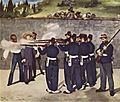1867 facts for kids
The year 1867 was a time of many important changes around the world. New countries were formed, and big steps were taken in science and engineering. Many famous people were born or passed away, leaving their mark on history.
Contents
Important Births
- April 6 – Wilbur Wright, who, with his brother, helped invent the airplane!
- April 9 – Chris Watson, who later became the third Prime Minister of Australia.
- November 7 – Marie Curie, a brilliant Polish-French chemist and physicist. She discovered new elements and won Nobel Prizes!
Famous People Who Died
- January 14 – Jean Auguste Ingres, a famous French painter.
- January 30 – Emperor Kōmei, the Emperor of Japan. His son would become the next emperor.
- May 12 – Friedrich William Eduard Gerhard, a German expert who studied ancient things (an archaeologist).
- June 19 – Maximilian, who was the Emperor of Mexico. He was sadly executed.
- August 25 – Michael Faraday, an English chemist and physicist who made big discoveries about electricity.
- August 31 – Charles Baudelaire, a well-known French writer.
Major Events of 1867
New Bridges and Voting Rights
- January 1 – The John A. Roebling Suspension Bridge opened. This amazing bridge connected Cincinnati, Ohio and Covington, Kentucky. It was the longest suspension bridge in the world at the time!
- January 8 – A big step for equality happened in Washington, D.C.. African-American men were given the right to vote there.
Changes in Japan and Mexico
- January 30 – Emperor Kōmei of Japan passed away. His son, Prince Mutsuhito, was expected to become the new emperor.
- February 3 – The Shogun (a military ruler) of Japan, Tokugawa Yoshinobu, stepped down. This meant the end of the old Shogun rule. Prince Mutsuhito officially became Emperor Meiji. This was a huge moment for Japan, starting a period of rapid change called the Meiji Restoration.
- January 11 – Benito Juárez became the president of Mexico again.
- June 19 – Emperor Maximilian of Mexico was executed by a firing squad. This event marked the end of the Second Mexican Empire.
Big Purchases and New Countries
- March 1 – Nebraska officially became the 37th U.S. state.
- March 29 – The British North America Act was approved. This important law created the country of Canada! It brought together several areas like Quebec, Ontario, New Brunswick, and Nova Scotia. July 1 became Canada Day, celebrating this new nation. John A. Macdonald became Canada's first prime minister.
- March 30 – The United States bought Alaska from Alexander II of Russia for $7.2 million. That's about 2 cents per acre! Some people thought it was a bad idea and called it "Seward's Folly" (after the U.S. Secretary of State William H. Seward).
- April 1 – The Strait Settlement of Singapore became a Crown Colony. This meant it was directly ruled by the British government in London.
Science and Other Events
- February 17 – The first ship sailed through the Suez Canal. This canal connects the Mediterranean Sea to the Red Sea, making sea travel much faster between Europe and Asia.
- March 16 – Joseph Lister published an important article in The Lancet. He wrote about his discovery of antiseptic surgery. This meant using clean methods to prevent infections during operations, saving many lives!
- May 29 – The Ausgleich (meaning "the Compromise") was made. This agreement created the Austro-Hungarian Monarchy, a powerful empire in Europe.
- July 17 – The Harvard School of Dental Medicine opened in Boston, Massachusetts. It was the first dental school in the United States.
- September 30 – The United States took control of Midway Island in the Pacific Ocean.
- October 21 – The Medicine Lodge Treaty was signed in Kansas. This treaty required several Native American Plains tribes to move to a reservation in Oklahoma.
- December 2 – The famous British writer Charles Dickens gave his first public reading in the United States in a New York City theater.
- December 4 – Oliver Hudson Kelley founded the Order of the Patrons of Husbandry, better known as the Grange movement. This group helped farmers.
Images for kids
-
January 1: The Roebling Bridge was the longest suspension bridge.
-
February 17: The Suez Canal was put into use.
-
Édouard Manet's Execution of Emperor Maximilian (1868–1869), showing the execution of Emperor Maximilian I of Mexico on June 19, 1867.
-
A map of Europe in 1867, after the forming of the North German Confederation and the Austro-Hungarian Compromise.
-
Emperor Maximilian I of Mexico
See also
 In Spanish: 1867 para niños
In Spanish: 1867 para niños

All content from Kiddle encyclopedia articles (including the article images and facts) can be freely used under Attribution-ShareAlike license, unless stated otherwise. Cite this article:
1867 Facts for Kids. Kiddle Encyclopedia.









